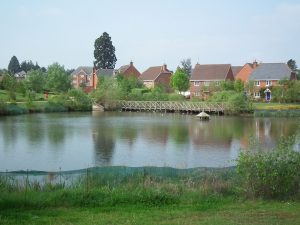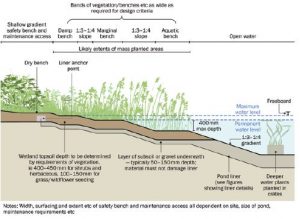I’m not sure if it is because we are an island nation or if there is something in our DNA however, we always seem to be drawn to water, whether it is holidays in the Lake District, walks along a river or paddling in the sea. So, incorporating an open water feature as part of a development should seem like a no-brainer… so why do we not use them more often?
This week we are heading back on a meander through the world of Sustainable Drainage Systems and will be taking a closer look at how ponds can be used as an attenuation feature and why you might want to think about incorporating one on your next project.
Figure 1: Example of a SuDS pond on a housing estate

Source: Hydro international (https://hydro-int.com/en/case-studies/englands-best-kept-suds-secret-0)
More than just a hole filled with water
OK so I know there is an element of teaching to suck eggs here but for completeness let us start with the basics, what is a pond?
Well to put it simply, it is just a permanent pool of water and you would be forgiven for thinking that in terms of design you would just need to dig a big enough hole to meet the attenuation requirements. It may therefore come as a surprise that the actual process is a little bit more complicated and in terms of drainage, the pond structure needs to incorporate several zones, which include:
- Sediment forebay – ok, so this one is technically optional; however, its inclusion does allow for some effective pre-treatment which can remove pollutants such as sediments before they get into the main body of water. It also enables you to have some control of water treatment by designating an area where pollutants can build-up and easily be monitored and removed.
- Permanent pool – this is the permanent volume of water that will always remain within the pond. It acts as the main treatment zone by allowing suspended solids to separate and in terms of design, your topwater level should be set at the same level as the invert of the outlet structure.
- Attenuation Storage Volume – when it comes to attenuation it is important to remember that when it rains your pond will already have water in it and therefore this volume cannot be included within your calculations. Your attenuation requirement will therefore need to be catered for within an additional volume above the normal water level which will only be utilised temporarily during rainfall events.
- Aquatic Bench – this is a shallow depth of water which runs around the perimeter of your pond. This zone serves several purposes which includes providing an area for planting which helps promote biodiversity and also create those amenity opportunities. This area also provides some additional safety benefits but we will go into that in a little more detail later.
Figure 2: Typical cross-section including zones

Source: CIRIA SuDS Manual C753
Why you should consider a pond
We have already looked at some of the benefits a pond can bring to your development like creating new habitats or improving water quality, but some others include:
- They can meet your entire drainage requirement – if sized correctly a pond can take the whole runoff from your site meaning that you potentially will only have one feature to maintain.
- In comparison to a buried system, you can see any problems and get access easily for maintenance.
- They could add value to your development and are generally well accepted by the public.
- They can still be used on contaminated sites providing that they are lined.
But what if someone drowns?
As an engineer, this is probably one of the biggest concerns I hear with relation to ponds and a lot of the time the solution that people want to adopt is to surround the feature with high fences to prevent access. The challenge with this approach is that while the attenuation and water quality elements are maintained the opportunity for it to be used for amenity is slightly lost.
Generally, people love using and having access to water. I found evidence of this while I was researching this blog when I stumbled across a recent study produced by HR Wallingford. As part of the study, they interviewed households across 7 sites that either had direct access to a pond or were located close by. When asking residents about safety they found that:
“In areas with well-established ponds, with rich marginal vegetation, safety was rarely perceived as an issue. At sites comprising newly established ponds, with limited or non-existent marginal vegetation, or where slopes were perceived to be over-steep, safety concerns were high.
Whenever safety was cited as a concern, the vast majority of participants (about 85%) still preferred to live next or near to a pond; rather than further away.
In all areas, a busy main road was considered to be the most dangerous hazard to live close to, while ponds were considered safer than rivers or landfill sites.”
(An Assessment of the Social Impacts of SuDS in the UK, HR Wallingford 2003)
So it would seem that even when end users are concerned about safety, they would still prefer to live next to a pond.
Now engineers always want their designs to be safe and there are lots of things that we can do to mitigate the risks associated with ponds. This could include positioning ponds within a well-viewed area of the site, making features bigger and shallower where space allows and ensuring all slopes are no greater than 1 in 3 which permits the majority of people to climb out unaided.
OK so ponds can be safe, but won’t they take up lots of space on my development?
With COVID-19, Brexit and a recession, we all know that it is a challenging time to be in business and it is unsurprising that when it comes to development, maximising opportunities on a site is seen as key to its success or failure.
When space is tight it can often seem preferable to get the drainage under the ground and out of the way, however, as you have potentially been following my blog for some weeks now you will know that by using this approach we could be missing out on those vital amenity and biodiversity benefits a well thought out SuDS system can provide. This is not ideal as we want to maximise the opportunities for our developments and use the drainage to help create spaces where people want to live and work.
So, let’s jump back into the Wallingford Study. Another area the survey looked at was the relationship between perceived property value and access to SuDS features. Now when residents were asked whether they thought being close to a pond increased the value of their homes the majority concerned that access to:
“Well designed and managed SUDS appear to have a positive affect on house saleability and on house prices. In areas with well-established ponds, there is perceived belief among the residents that their properties would fetch a 10% premium, along with an increase in saleability. Where houses were sited close to poorly designed and / or maintained ponds, it was felt that the saleability and price may be compromised.”
(An Assessment of the Social Impacts of SuDS in the UK, HR Wallingford 2003)
So generally, the report shows that residents not only like access to ponds but also believe, if well maintained and aesthetically pleasing it can increase the sales values of their properties.
But what if space really is an issue?
So, what if after reading this article you are well and truly in team pond, but you are only working with a small site?
Well, the great news is that your pond does not need to be designed to take all your site runoff. As engineers can develop the system to work alongside other SuDS features which can not only improve water quality but also reduce the size of your pond while still enabling you to maximise on those important amenity benefits.
Summary
Ponds can potentially bring many benefits to a site, including helping to create spaces where people want to live and work, providing new habitats for wildlife and improving the quality of our runoff, however, like most things, to maximise the opportunity, we need to ensure that they are designed so that they can be properly maintained.
If you would like to find out some of the other findings of the Wallingford report, I have popped a link to the study below.
(https://www.susdrain.org/files/resources/evidence/HRW_social_impact_summary.pdf)